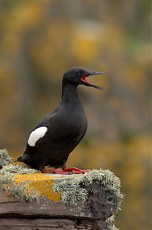
If you want close-up views of tens of thousands of breeding Gannets, alongside Guillemots, Puffins, Razorbills, Kittiwakes, Fulmars, head for Sumburgh Head, Noss or Hermaness nature reserves. These three large seabird colonies are easily accessible, Sumburgh Head especially so. On Noss and Hermaness, and on coastal moorland elsewhere, youll probably encounter Great Skuas ('Bonxies'), famously rare and aggressive, gull-sized birds, which are fond of dive-bombing hill walkers. To reduce the risk of being hit, keep to any marked path or trail and hold a stick or something similar above your head. More than half the world's population of this species breeds in Shetland. You may also come across the equally feisty Arctic Skua.
Sumburgh Head RSPB reserve is the most accessible seabird colony in Shetland and is particularly good for less able people. The Sumburgh cliffs are home to thousands of seabirds in the breeding season, with Puffins, Guillemots, Razorbills, Fulmars, Kittiwakes and Shags easily viewed. It is also one of the best places in Shetland to watch for sea mammals.
Noss is one of the most spectacular wildlife sights in Europe, just 40 minutes by sea from Lerwick, the Shetland capital. You can take a 3-hour boat trip around the cliffs or make your way across the isle ofBressay for the 200-yard ferry crossing of Noss Sound and spend a day walking on the island. The first sight of Noss always sticks in visitors' memories, even if they've no previous interest in birds. The spectacle of 20,000 Gannets, 40,000 Guillemots and 5,000 Kittiwakes festooned over a mile of cliffs, up to 592' (181m) high, is simply astounding, as is the roar of the massed 'choir' of parents and chicks.
Hermaness, which includes the dramatic precipices of the Muckle Flugga stacks off the northern tip of Unst, has even more Gannets and is one of the best places to see the aerobatic (but smaller) Bonxies attacking them and stealing their food. The Puffins on Hermaness and the neighbouring headland of Saxa Vord probably number over 100,000 and are astonishingly tame. As at Noss, the reserve is privately owned but managed by Scottish Natural Heritage, whose wardens are always happy to show visitors around.
Another prime bird watching location is the RSPB reserve on the island ofFetlar. The island boasts fine views of birds such as Skuas and Terns. but is famous as the summer home of one of Britain's rarest breedng birds - the Red Necked Phalarope. Fetlar accounts for 90% of the UK population of these remarkably tame birds. In June and July they can be seen at close quarters from an RSPB hide on the shores of the Loch of Funzie. Another rare bird, the Whimbrel, also nests in Fetlar. Around 80 pairs breed on the island, which is 15% of the UK breeding population. In the past Fetlar has even had the UK's only pair of breeding Snowy Owls.
For wildfowl, the RSPB Reserve at the Loch of Spiggie is particularly good in autumn and winter. It's notable for Whooper Swans on their migration, and there are good numbers of ducks such as the Tufted and Goldeneye.
Slightly harder to get to, but well worth the effort, are Foula (probably the Bonxie capital of the world) and Fair Isle, with its famous bird observatory. Both islands offer superb birding in beautiful surroundings, as do the much less well-known Out Skerries.
Another Shetland speciality is the Storm Petrel. A night visit with the Mousa Ferry to the spooky and astonishingly noisy breeding colony in the 2,500-year-old broch on the uninhabited island of Mousa is a must - one of the highlights of a Shetland holiday.
Mousa is an RSPB reserve. In addition to the Storm Petrels at night time, there are Arctic and Great Skuas, Arctic Terns, Gulls, and many other birds easily viewed.
The Shetland breeding list includes Red-throated Divers, and waders and moorland birds such as Snipe, Dunlin, Golden Plover, Redshank, Ringed Plover, Lapwing, Curlew, the much rarer Whimbrel and even a few Whooper Swans.
Updated Aug 21, 2011
Address: Victoria Pier Slipway
Phone: +44 (0) 7595 540 224
Website: http://www.seabirds-and-seals.com/